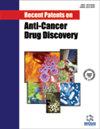将 HMGA2-AS1 作为与胃癌免疫浸润相关的预后生物标记物的生物信息学分析和实验验证
IF 4.1
4区 医学
Q3 ONCOLOGY
Recent patents on anti-cancer drug discovery
Pub Date : 2024-04-03
DOI:10.2174/0115748928284459240318070914
引用次数: 0
摘要
背景:天然反义长非编码 RNA(lncRNA)能够调节相应有义基因的表达。因此,这些 lncRNA 的任何失调都可能导致病理过程的发展。围绕 HMGA2-AS1 在胃癌(GC)中作用的模糊性需要进一步研究。研究目的本研究旨在探讨 HMGA2-AS1 在 GC 中的参与情况。方法本研究采用了 Kaplan-Meier 法、Cox 回归分析、基因组富集分析(GSEA)和免疫浸润分析。这些方法用于评估临床特征与HMGA2-AS1表达之间的关系、预后因素以及HMGA2-AS1的重要功能影响。采用实时定量聚合酶链反应(qRT-PCR)验证了GC细胞系中HMGA2-AS1的水平。结果显示在确诊为 GC 的患者中,HMGA2-AS1 的高表达与 T 期之间存在显著相关性(p = 0.01)。此外,HMGA2- AS1 的高表达被认为是较差 OS(p = 0.004)、PFS(p = 0.006)和 DSS(p = 0.011)的预后指标。此外,HMGA2-AS1的表达(p < 0.001)与GC患者的OS有独立关联。HMGA2-AS1 低表达表型的存在与各种通路的不同富集有关,包括局灶粘附-PI3K-Akt-mTOR 信号通路、局灶粘附、ECM 糖蛋白、促进细胞运动的 MET 等。此外,HMGA2-AS1 的表达还与 B 细胞、CD56 明亮细胞、TFH 和 Th17 细胞相关。此外,GC 细胞系的 HMGA2-AS1 表达量明显更高。结论GC患者中HMGA2-AS1表达的升高与不利的生存结果和免疫浸润的增加有明显的相关性。这表明,HMGA2- AS1 有望成为一种潜在的预后生物标志物和 GC 免疫疗法的靶点。本文章由计算机程序翻译,如有差异,请以英文原文为准。
Bioinformatic Analysis and Experimental Validation of HMGA2-AS1 as a Prognostic Biomarker Associated with Immune Infiltration in Gastric Cancer
Background: Natural antisense long noncoding RNAs (lncRNAs) have the ability to modulate the expression of their corresponding sense genes. Consequently, any dysregulation of these lncRNAs can contribute to the development of pathological processes. The ambiguity surrounding the role of HMGA2-AS1 in gastric cancer (GC) requires further investigation. Objective: The aim of this study was to examine the involvement of HMGA2-AS1 in GC. Methods: The Kaplan-Meier method, Cox regression analysis, gene set enrichment analysis (GSEA), and immune infiltration analysis were used in this study. These methods were used to evaluate the relationship between clinical characteristics and HMGA2-AS1 expression, prognostic factors, and the significant functional impact of HMGA2-AS1. HMGA2-AS1 levels in GC cell lines were validated using quantitative real-time polymerase chain reaction (qRT-PCR). Results: In patients diagnosed with GC, a significant correlation was observed between high expression of HMGA2-AS1 and the T stage (p = 0.01). Furthermore, the high expression of HMGA2- AS1 was identified as a prognostic indicator for poorer OS (p = 0.004), PFS (p = 0.006), and DSS (p = 0.011). Furthermore, the expression of HMGA2-AS1 (p < 0.001) demonstrated an independent association with OS in patients with GC. The presence of a low expression phenotype of HMGA2-AS1 was associated with differential enrichment of various pathways, including the focal adhesion-PI3K-Akt-mTOR signaling pathway, focal adhesion, ECM glycoproteins, MET promoting cell motility, among others. Furthermore, the expression of HMGA2-AS1 exhibited correlations with B cells, CD56 bright cells, and TFH and Th17 cells. Furthermore, GC cell lines demonstrated significantly higher expression of HMGA2-AS1. Conclusion: Elevated expression of HMGA2-AS1 in GC patients exhibited a significant correlation with unfavorable survival outcomes and increased immune infiltration. This suggests that HMGA2- AS1 holds promise as a potential prognostic biomarker and target for immunotherapy in GC.
求助全文
通过发布文献求助,成功后即可免费获取论文全文。
去求助
来源期刊
CiteScore
4.50
自引率
7.10%
发文量
55
审稿时长
3 months
期刊介绍:
Aims & Scope
Recent Patents on Anti-Cancer Drug Discovery publishes review and research articles that reflect or deal with studies in relation to a patent, application of reported patents in a study, discussion of comparison of results regarding application of a given patent, etc., and also guest edited thematic issues on recent patents in the field of anti-cancer drug discovery e.g. on novel bioactive compounds, analogs, targets & predictive biomarkers & drug efficacy biomarkers. The journal also publishes book reviews of eBooks and books on anti-cancer drug discovery. A selection of important and recent patents on anti-cancer drug discovery is also included in the journal. The journal is essential reading for all researchers involved in anti-cancer drug design and discovery. The journal also covers recent research (where patents have been registered) in fast emerging therapeutic areas/targets & therapeutic agents related to anti-cancer drug discovery.

 求助内容:
求助内容: 应助结果提醒方式:
应助结果提醒方式:


